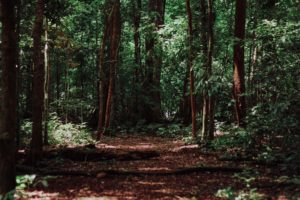
Upland-Coniferous-Forest

Upland Coniferous Forest
Forests tend to populate themselves with species common to that particular area. Healthy forests have multiple tree types, like Ponderosa Pine and Green Spruce; another site may have a single species like Jack Pine. In most cases, flourishes depend on the topography and soil conditions. The Upland Coniferous Forest is home to many species of birds and animals that are also common to that area.
When I look at a coniferous forest, it immediately brings me to release the concerns of day-to-day life. It permits me to let go of worries and control of things. I like listening to the wind and how to play through the forest. At times the birds are the primary voice; other times, it is the trees themselves, and still other times, the animals will pass by if you sit very quietly. They know you are there, but they will look and keep going; they can tell you are no threat to them. Their silent look, their studying of you, brings them this confidence.
We can teach our kids and ourselves to be flexible with life. Let go of the requirements that things be a certain way or have a specific outcome. If you are sitting quietly in the forest and an animal is within your midst, say a deer. They will proceed with caution, and then they will go about their business of eating quietly. If you need to move a bit, they will notice, but they will likely barely even move if it isn’t sudden. How can we take the time to be more patient? If you do move quickly, they will run a bit and then stop to see any further danger and eat.
Regardless of the outcome, flexibility is an attitude of adoption that we can choose to make. We can learn this by being open to any development or situation and adjusting like the deer that runs a few steps and goes about eating.
Teach your kids to be flexible, not “expect” outcomes in the sense that they have to be a certain way. Helping kids learn to accept the life changes, even when inconvenient, gives them strength when they need to go on in difficult times. Teaching them to respond in various situations helps them understand how to offer and warns them of rigidness and stiffness that often comes with our set expectations.
A big part of learning flexibility involves attitude. Click here for writing on this ever-important word, Parenting on Purpose: Attitude – Dr. Rich Patterson (pattersonphd.com)
Very Well Mind has a post on Attitudes and Behavior in Psychology that details attitude formation. Click here, Attitudes and Behavior in Psychology (verywellmind.com)
Learning from the Upland Coniferous Forest teaches us the wilderness’s flexibility, how it responds to fire, and other complex conditions. Here’s what I know: When we dig our expectations in that, we’re often disappointed.
Enjoy some time in the forest.
Rich
Let’s Connect!